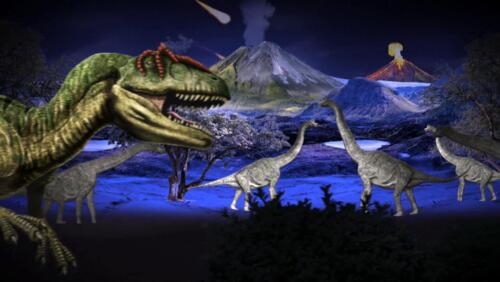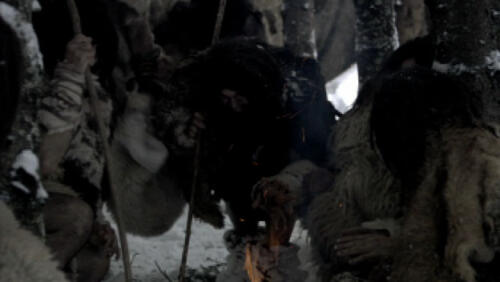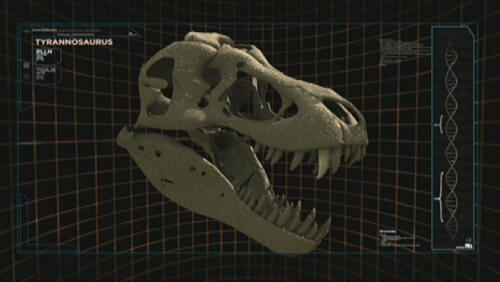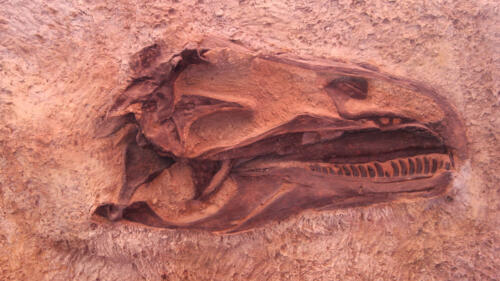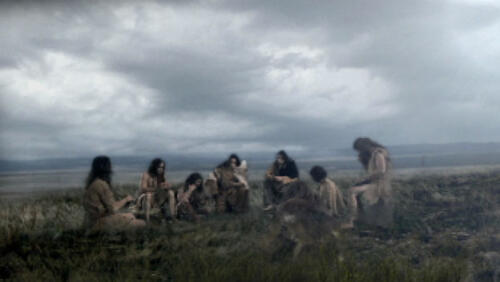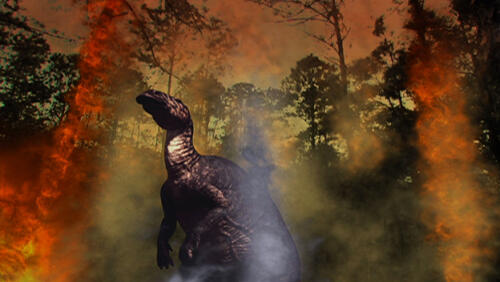Prehistory
Prehistory, the vast period of time before written records or human documentation, includes the Neolithic Revolution, Neanderthals and Denisovans, Stonehenge, the Ice Age and more.
Featured Overview
Take a look at the animals (and one fungus!) that have had a huge effect on the human race.
4:07m watch

Getty Images/iStockphoto
Featured Overview
Take a look at the animals (and one fungus!) that have had a huge effect on the human race.
4:07m watch
Start Here

The Cretaceous-Tertiary extinction event, or the K-T event, is the name given to the die-off of the dinosaurs that took place some 65.5 million years ago. For many years, paleontologists believed this event was caused by climate change that interrupted the dinosaurs’ food supply, but later, scientists discovered iridium, suggesting a comet, asteroid or meteor impact event may have caused the mass extinction.

Our human ancestors may have lost 98.7 percent of their population around 900,000 to 800,000 years ago, according to genetic research.

Some of the oldest known art may hint at the beginning of language development, while later examples portray narratives with human and animal figures.

More than 3,200 years ago, a vast, interconnected civilization thrived. Then it suddenly collapsed. What happened?
Unearthing Dinosaurs
Unearthing Dinosaurs
Dinosaurs can reveal fascinating details of how life was 65 million years ago. But unearthing them can prove to be challenging.
1:45 watch

3 Bronze Age Weapons
Explore All Related Topics

A 2,500-year-old mummy of a tattooed woman in a silk blouse was found in the remote Altai region of Central Asia. Who was she—and what does she reveal about her ancient people?

From detecting lost cities of the Amazon to tracing our history with Neanderthals, these were among 2024's most fascinating discoveries.

The first known illustration of a dinosaur bone is from 1677. The man who wrote about it thought it might belong to a giant.

Early human ancestors used these spaces for shelter, but also in ways that are hard to decipher—like the mysterious stalagmite circles at France's Bruniquel Cave.

The stunning 1974 discovery offered proof that ancient hominins were walking around on two feet some 3.2 million years ago.

The Tyrannosaurus rex fossil known as Sue carries a controversial past—and has revealed fearsome facts about its species.

Organized warfare appears to have started in the Neolithic Age and then ramped up during the Bronze Age.

Our human ancestors may have lost 98.7 percent of their population around 900,000 to 800,000 years ago, according to genetic research.

Many of these giant mammals may have been hunted into extinction as prehistoric humans expanded into North America.

Did humans first set foot in the Americas after walking—or sailing or paddling by sea?

A study claiming that human ancestors living between 240,000 and 500,000 years ago may have intentionally buried their dead, raises the question of when this behavior began.

Some of the oldest known art may hint at the beginning of language development, while later examples portray narratives with human and animal figures.

New techniques helped make iron stronger—but there were also innovations in the use of gold, silver and stone.

The introduction of bronze led humans to develop array of new, intimidating weaponry.

More than 3,200 years ago, a vast, interconnected civilization thrived. Then it suddenly collapsed. What happened?

Our human ancestors' big, creative brains helped them devise tools and strategies to survive harsh climates.

The story of human origins is complicated since our ancestors swapped genes (and probably skills).

Why go to the trouble of tracking and killing an animal when a saber-tooth cat can do the job instead?

For roughly 2.5 million years, humans lived on Earth without leaving a written record of their lives—but they left behind other kinds of remains and artifacts.

From sharpened rocks to polished stone axes, Stone Age human ancestors made progressively more complex devices over 2.6 million years.

The man who discovered the species was a miner working in an Australian opal field.

Early man's diet transitioned to animal flesh with an assist from the saber-toothed tiger.

The massive dinosaur also lived longer than any other T. rex discovered to date.

A malignant tumor found in a 240 million-year-old turtle bone shows that cancer has been plaguing living things since the Triassic Period.

The prehistoric beasts roamed the earth 10,000 years ago—and scientists are obsessed with bringing them back.

Early humans may have been primitive—but they had some sophisticated habits and tastes.

New DNA research has unexpectedly revealed that they were even more promiscuous than we thought.

The Stone Age marks a period of prehistory in which humans used primitive stone tools. Lasting roughly 2.5 million years, the Stone Age ended around 5,000 years ago when humans began working with metal and making tools and weapons from bronze.

The Neolithic Revolution, also called the Agricultural Revolution, marked the transition in human history from small, nomadic bands of hunter-gatherers to larger, agricultural settlements and early civilization. It started around 10,000 B.C.

Hunter-gatherers were prehistoric nomadic groups that harnessed the use of fire, developed intricate knowledge of plant life and refined technology for hunting and domestic purposes as they spread from Africa to Asia, Europe and beyond.

The Iron Age was a period in human history that started between 1200 B.C. and 600 B.C. During the Iron Age, people across much of Europe, Asia and parts of Africa began making tools and weapons from iron and steel.

The Bronze Age marked the first time humans started to work with metal. Bronze tools and weapons soon replaced earlier stone versions. Ancient Sumerians in the Middle East may have been the first people to enter the Bronze Age.

The Fertile Crescent, also known as the “Cradle of Civilization,” is the boomerang-shaped region of the Middle East that was home to some of the earliest human civilizations.

The dinosaur's puny arms were nothing to laugh at.

Neanderthals, an extinct species of hominids, were the closest relatives to modern human beings.

Scientists may have solved the 66-million-year-old mystery of what doomed the dinosaurs.
Take a look at the animals (and one fungus!) that have had a huge effect on the human race.
4:07m watch

An unprecedented DNA study has found evidence of a single human migration out of Africa and confirmed that Aboriginal Australians are the world’s oldest civilization.

In a new study, researchers claim to have solved the mystery of how the early human ancestor known as Lucy died nearly 3.2 million years ago.

A new study has challenged the popular theory that the first Ice-Age humans who migrated to North America arrived by a land bridge connecting Siberia to Alaska.

The ritual gesture has existed since ancient times—but its use as an everyday greeting is a more recent phenomenon.

A Michigan farmer reaped a startling harvest last week when he unearthed the partial skeleton of a prehistoric mammoth in his wheat field.

In a pile of unpromising dinosaur fossils dug up in Canada a century ago, British scientists find soft tissue materials preserved for some 75 million years.

From the Terra Cotta Army to the Dead Sea Scrolls, get the stories behind seven chance encounters that led to the discovery of priceless historical relics.

An ice age is a period of colder global temperatures and recurring glacial expansion capable of lasting hundreds of millions of years.

Scientists seeking to clone the long-extinct woolly mammoth may have found the best hope yet of achieving their controversial goal.

How does our modern take on the Paleo diet compare to what our ancestors actually ate?

New research indicates that tuberculosis bacteria originated with early humans some 70,000 years ago, before they migrated from their African homeland.

A new study has cast doubt on a popular theory that Homo sapiens and Neanderthals once co-existed in Europe.
Get the full story behind the extinction of the mammoth species that once roamed the earth.
1:59m watch
Salt—necessary for human life—was once a highly prized commodity that could not be easily accessed in many parts of the world.
2:31m watch
Clovis points found on the east coast of the U.S. challenge the traditional theory that the Clovis people migrated to North-America via the Bering land bridge.
3:51m watch
Genetic analysis helps to decipher the mysteries of human evolution.
4:16m watch
Paleonthropologists attempt to explain the fossil evidence of cannibalism among the Neanderthals.
3:32m watch
When did early humans first develop spoken language?
3:29m watch
Known as the "king of the tyrant lizards," T-Rex was one of the largest carnivores of all time.
1:25m watch
Did Cro Magnons, the ancestors of early humans, cause the Neanderthal extinction?
3:17m watch
DNA evidence may prove whether Cro Magnon and Neanderthal interbreeding was possible and what traces might be left in the genome of modern humans.
3:58m watch
Dinosaurs can reveal fascinating details of how life was 65 million years ago. But unearthing them can prove to be challenging.
1:45m watch
A 1,000 year-long ice age known as the Younger Dryas may have brought together different groups of prehistoric humans from across the Americas.
3:26m watch
Scientists believe a combination of disastrous events may have led to the extinction of the dinosaurs.
4:04m watch

Early humans made sophisticated stone tools like hand axes 1.8 million years ago, a cache of artifacts from Kenya suggests.

The Cretaceous-Tertiary extinction event, or the K-T event, is the name given to the die-off of the dinosaurs that took place some 65.5 million years ago. For many years, paleontologists believed this event was caused by climate change that interrupted the dinosaurs’ food supply, but later, scientists discovered iridium, suggesting a comet, asteroid or meteor impact event may have caused the mass extinction.

The prehistoric reptiles known as dinosaurs arose during the Middle to Late Triassic Period of the Mesozoic Era, some 230 million years ago. They were members of a subclass of reptiles called the archosaurs (“ruling reptiles”), a group that also includes birds and crocodiles.




